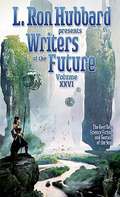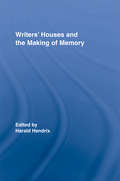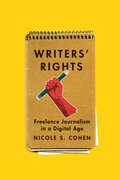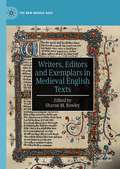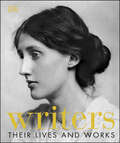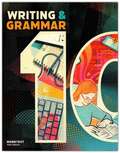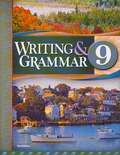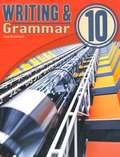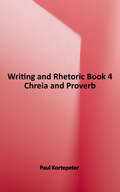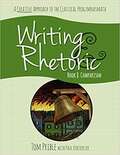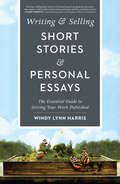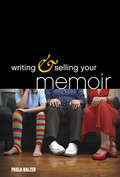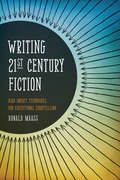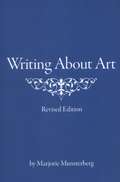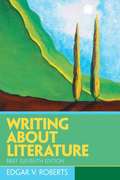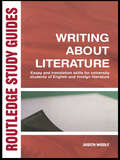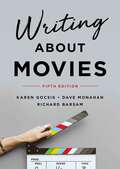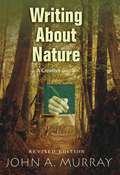- Table View
- List View
Writers of the Future, Vol 26
by L. Ron Hubbard K. D. WentworthDiscover Imaginative New Worlds of Tomorrow. Discover the new visionaries of imagination in the Writers of the Future. Established in 1983 by L. Ron Hubbard expressly for the aspiring writer, Writers of the Future has become the most respected and significant forum for new talent in all aspects of speculative fiction. Never before published first-rate science fiction and fantasy stories selected by top names in the field. "Not only is the writing excellent...it is also extremely varied. There's a lot of hot new talent in it." --Locus Magazine
Writers on the Spectrum
by Julie BrownFrom Hans Christian Andersen's fairytale characters to Lewis Carroll's Wonderland and Emily Dickinson's poetic imagery, the writings and lives of some of the world's most celebrated authors indicate signs of autism and Asperger's Syndrome. Through analysis of biographies, autobiographies, letters and diaries, Professor Julie Brown identifies literary talents who display characteristics of Autistic Spectrum Disorder (ASD) and uncovers the similarities in their writing that suggest atypical, autistic brains. Providing close readings of authors' works, Brown explores writing processes, content, theme, structure and writing style to reveal the underlying autistic traits that have influenced their writing. The book provides an overview of ASD and common threads in autistic writing followed by an illuminating exploration of how these threads are evident in the literature of both well-known and lesser known authors. This groundbreaking study of autism in literature will be of interest to anyone with a professional or personal interest in literature or the autistic mind.
Writers' Houses and the Making of Memory (Routledge Research in Cultural and Media Studies #Vol. 11)
by Harald HendrixThis innovative new book examines the ways in which writers’ houses contribute to the making of memory. It shows that houses built or inhabited by poets and novelists both reflect and construct the author’s private and artistic persona; it also demonstrates how this materialized process of self-fashioning is subsequently appropriated within various strategies and policies of cultural memory.
Writers' Retreats: Literary Cabins, Creative Hideaways, and Favorite Writing Spaces of Iconic Authors
by Neil BurkeyFeaturing over 50 writers and their getaways--get a glimpse into the creative habits of some of the greatest writers of the last two centuries. From Henry David Thoreau's famous cabin at Walden Pond and James Baldwin's 'Welcome Table' in Provence, to Roald Dahl's garden hut and Toni Morrison's sunrise-lit couch at dawn, Writers' Retreats reveals the quirky, private, and sometimes curious places where literary magic has happened. Each location is brought to life through illustration and the writer's own words on what made that place so perfect for creating.An exploration of famous literary writers of past and present, from Emily Dickinson and Marcel Proust to Margaret Atwood, Chimamanda Ngozi Adichie, and Alice Munro, this is the perfect bookish gift for both writers and booklovers to feed their fascination with what ignited the creativity behind their favorite works of literature.
Writers' Rights: Freelance Journalism in a Digital Age
by Nicole S. CohenAs media industries undergo rapid change, the conditions of media work are shifting just as quickly, with an explosion in the number of journalists working as freelancers. Although commentary frequently lauds freelancers as ideal workers for the information age - adaptable, multi-skilled, and entrepreneurial - Nicole Cohen argues that freelance media work is increasingly precarious, marked by declining incomes, loss of control over one's work, intense workloads, long hours, and limited access to labour and social protections. Writers' Rights provides context for freelancers' struggles and identifies the points of contention between journalists and big business. Through interviews and a survey of freelancers, Cohen highlights the paradoxes of freelancing, which can be simultaneously precarious and satisfying, risky and rewarding. She documents the transformation of freelancing from a way for journalists to resist salaried labour in pursuit of autonomy into a strategy for media firms to intensify exploitation of freelance writers' labour power, and presents case studies of freelancers' efforts to collectively transform their conditions. A groundbreaking and timely intervention into debates about the future of journalism, organizing precariously employed workers, and the transformation of media work in a digital age, Writers' Rights makes clear what is at stake for journalism's democratic role when the costs and risks of its production are offloaded onto individuals.
Writers' Rights: Freelance Journalism in a Digital Age
by Nicole S. CohenAs media industries undergo rapid change, the conditions of media work are shifting just as quickly, with an explosion in the number of journalists working as freelancers. Although commentary frequently lauds freelancers as ideal workers for the information age – adaptable, multi-skilled, and entrepreneurial – Nicole Cohen argues that freelance media work is increasingly precarious, marked by declining incomes, loss of control over one’s work, intense workloads, long hours, and limited access to labour and social protections. Writers’ Rights provides context for freelancers’ struggles and identifies the points of contention between journalists and big business. Through interviews and a survey of freelancers, Cohen highlights the paradoxes of freelancing, which can be simultaneously precarious and satisfying, risky and rewarding. She documents the transformation of freelancing from a way for journalists to resist salaried labour in pursuit of autonomy into a strategy for media firms to intensify exploitation of freelance writers’ labour power, and presents case studies of freelancers’ efforts to collectively transform their conditions. A groundbreaking and timely intervention into debates about the future of journalism, organizing precariously employed workers, and the transformation of media work in a digital age, Writers’ Rights makes clear what is at stake for journalism’s democratic role when the costs and risks of its production are offloaded onto individuals.
Writers, Editors and Exemplars in Medieval English Texts (The New Middle Ages)
by Sharon M. RowleyThis collection of essays explores the literary legacy of medieval England by examining the writers, editors and exemplars of medieval English texts. In order to better understand the human agency, creativity and forms of sanctity of medieval England, these essays investigate both the production of medieval texts and the people whose hands and minds created, altered and/or published them. The chapters consider the writings of major authors such as Chaucer, Gower and Wyclif in relation to texts, authors and ideals less well-known today, and in light of the translation and interpretive reproduction of the Bible in Middle English. The essays make some texts available for the first time in print, and examine the roles of historical scholars in the construction of medieval English literature and textual cultures. By doing so, this collection investigates what it means to recover, study and represent some of the key medieval English texts that continue to influence us today.
Writers: Their Lives and Works (DK History Changers)
by DKExplore the fascinating lives and loves of the greatest novelists, poets, and playwrights.From William Shakespeare and Jane Austen to Gabriel García Márquez and Toni Morrison, Writers explores more than 100 biographies of the world&’s greatest writers. Each featured novelist, playwright, or poet is introduced by a stunning portrait, followed by photography and illustrations of locations and artifacts important in their lives – along with pages from original manuscripts, first editions, and their correspondence. Trace the friendships, loves, and rivalries that inspired each individual and affected their writing, revealing insights into the larger-than-life characters, plots, and evocative settings that they created. You will also uncover details each writer&’s most famous pieces and understand the times and cultures they lived in – see how the world influenced them and how their works influenced the world.Writers introduces key ideas, themes, and literary techniques of each figure, revealing the imaginations and personalities behind some of the world's greatest novels, short stories, poems, and plays. A diverse variety of authors are covered, from the Middle Ages to present day, providing a compelling glimpse into the lives of the people behind the page.
Writer’s Journal, Grade 5, Unit 4: Contemporary Fiction with excerpts from The House on Mango Street
by Core Knowledge FoundationNIMAC-sourced textbook
Writing
by Barry B. PowellWriting: Theory and History of the Technology of Civilization traces the origins of writing tied to speech from ancient Sumer through the Greek alphabet and beyond. Examines the earliest evidence for writing in Mesopotamia in the fourth millennium BC, the origins of purely phonographic systems, and the mystery of alphabetic writing Includes discussions of Ancient Egyptian,Chinese, and Mayan writing Shows how the structures of writing served and do serve social needs and in turn create patterns of social behavior Clarifies the argument with many illustrations
Writing & Grammar 9
by Elizabeth Rose Dawn L. Watkins Denise L. Patton Dana Gibby GagePeople study language for a variety of reasons. Some study in order to secure a job that pays better; some study to make good grades or to impress others with their vocabulary and knowledge. Some may actually study grammar and mechanics for the fun of it! You might ask yourself whether those reasons are good ones. Why should a Christian study the English language? Christians should study language and any other subject seriously because of Who God is. Just think about the fact that the God of the universe used language to bring the world into existence (Gen. 1:3)! God created every man and woman in His own image, and He called mankind to exercise dominion over the earth. Exercising dominion is accomplished in part through man's use of language (Gen. 1:28; 2:19-20). Perhaps the most exciting aspect of English study is the part language plays in God's plan to redeem the world to Himself (John 1:1-18). Part of that plan could be for Christians to use language for redemptive purposes. One example of such a redemptive purpose might be writing a play that confronts an audience with a distinctively Christian way to handle conflict. Blogging from a biblical worldview about issues facing the culture would be another example.
Writing & Grammar Grade 10 Student Text (Fourth Edition)
by Bob Jones UniversityThis updated fourth edition of BJU Press' Writing and Grammar, Grade 10 student text features full-color pages with historical examples and context from all eras. Charts, sample sentences, enrichment focusing on thinking skills and Bible letters, and ESL notes all provide additional insights and interest to the chapter's primary focus. Lessons feature an excerpt, grammar exercises, and writing activities. This grade 10 text covers parts of speech, sentences, phrases, clauses, agreement, verb use, pronoun reference, capitalization, punctuation, writing, library skills, study skills, and more.
Writing & Rhetoric Book 4: Chreia & Proverb
by Paul KortepeterThe Writing and Rhetoric series method employs fluent reading, careful listening, models for imitation, and progressive steps. It assumes that students learn best by reading excellent, whole-story examples of literature and by growing their skills through imitation. Each exercise is intended to impart a skill (or tool) that can be employed in all kinds of writing and speaking. The exercises are arranged from simple to more complex. What's more, the exercises are cumulative, meaning that later exercises incorporate the skills acquired in preceding exercises. This series is a step-by-step apprenticeship in the art of writing and rhetoric.
Writing & Rhetoric Book 8: Comparison
by Paul Kortepeter Tom PribleIn Writing & Rhetoric Book 8: Comparison (Student Edition), students will be writing well-crafted, six-paragraph expository essays comparing two subjects. Comparisons can be made between people, historical events, ideas, inventions, animals, foods"just about anything, really. The purpose of these essays is to analyze two subjects and use this comparison to demonstrate similarities and differences between them. In these essays, students will be making use of a range of writing skills, including the ability to inform, to describe, to narrate, and to analyze.
Writing & Selling Short Stories & Personal Essays: The Essential Guide to Getting Your Work Published
by Windy HarrisWrite It Short, Sell It Now Short stories and personal essays have never been hotter--or more crucial for a successful writing career. Earning bylines in magazines and literary journals is a terrific way to get noticed and earn future opportunities in both short- and long-form writing.Writing & Selling Short Stories & Personal Essays capitalizes on the popularity of these genres by instructing on the two key steps to publishing short works: crafting excellent pieces and successfully submitting them. You'll learn how to:Develop different craft elements--including point of view, character, dialogue, scene writing, and more--specifically for short stories and essays.Recognize the qualities of excellent short works, using examples from recently published stories and essays in major journals.Understand the business of writing short, from categorizing your work and meeting submission guidelines to networking and submitting to writing contests.Master the five-step process for submitting and selling like a pro.Featuring advice and examples from a multitude of published authors, Writing & Selling Short Stories & Personal Essays is a must-have for any writer's bookshelf.
Writing & Selling Your Memoir: How to Craft Your Life Story So That Somebody Else Will Actually Want to Read It
by Paula BalzerThere's more to writing a memoir than just writing your life story. A memoir isn't one long diary entry. Rather, it's a well-crafted story about a crucial, often exceptionally difficult, time in someone's life. Writing & Selling Your Memoirtalks readers through the process of telling their most personal stories in a compelling, relatable, and readable manner. Unlike other books dedicated to the art and craft of writing memoir, it teaches readers how to approach the genre with love, respect, and know-how without sentimentalizing it. Drawing on her experience working with New York Times best-selling memoirists, literary agent Paula Balzer carefully explores the genre and provides readers with step-by-step instruction on how to: Identify strong opening and closing points Find and develop a strong central hook that readers can relate to Structure a memoir to maximize readability Use dialogue and pacing to enhance intimacy Approach honesty and truthfulness Build a successful author platform around their memoir Get an agent's attention Get published Full of tips, techniques, detailed exercises, and examples from best-selling memoirs as well as sidebars from well-known memoir authors,Writing & Selling Your Memoirteaches you how to approach an often tricky genre and tell your story without sentimentalizing it.
Writing 21st Century Fiction: High Impact Techniques for Exceptional Storytelling
by Donald MaassWhat is it that makes twenty-first century fiction different from twentieth century fiction? It's a real issue, attested by slush piles that are chock full of stories that are weak and lifeless. The writing is old-fashioned and stale, crafted by authors following outmoded and stifling "rules" once thought necessary in order to get published. Author and literary agent Donald Maass eliminates that restrictive philosophy by deconstructing the techniques used to craft successful (often best-selling) recent novels. He'll push you beyond the boundaries of genre, beyond outdated styles, and beyond your safety zones. You'll discover new ways of writing fiction that are personal, unique, and contemporary, resulting in fiction that is both literaryandcommercial.
Writing A Report, 9th Edition: How To Prepare, Write And Present Really Effective Reports
by John BowdenNow in its 9th edition, this extensively revised and updated handbook explains how you can write reports that will be: * Read without unnecessary delay * Understood without undue effort Accepted, and where applicable, acted upon / Divided into three parts, the book looks in detail firstly at the practical side of report writing: * Preparation and planning * Collecting and handling information * Writing and revising / Secondly, at the creative side of report writing: * Achieving a good style and choosing the correct words * Improving the overall appearance of reports / And thirdly at 23 common types of report, including: * Annual reports/ Appraisal reports * Audit reports Minutes/Progress reports * Student project reports/Technical reports / There is also an extensive glossary and a selection of sample reports.
Writing A Report, 9th Edition: How to prepare, write & present really effective reports
by John BowdenNow in its 9th edition, this extensively revised and updated handbook explains how you can write reports that will be: * Read without unnecessary delay * Understood without undue effort Accepted, and where applicable, acted upon / Divided into three parts, the book looks in detail firstly at the practical side of report writing: * Preparation and planning * Collecting and handling information * Writing and revising / Secondly, at the creative side of report writing: * Achieving a good style and choosing the correct words * Improving the overall appearance of reports / And thirdly at 23 common types of report, including: * Annual reports/ Appraisal reports * Audit reports Minutes/Progress reports * Student project reports/Technical reports / There is also an extensive glossary and a selection of sample reports.
Writing About Art (Revised Edition)
by Marjorie MunsterbergWriting About Art was written as the text for a course of the same name required of all art majors at The City College of New York. The book explains the different approaches college students encounter in undergraduate art history classes. Each chapter outlines the characteristics of one type of visual or historical analysis and briefly explains its history and development. Passages by well-known art historians provide examples of each method. Sample essays by students are accompanied by extensive explanations of suggested revisions. The book also includes a step-by-step guide to researching art historical topics and a section about correctly citing sources.
Writing About Literature (Brief Eleventh Edition)
by Edgar V. RobertsThe aim of the book is to help students to read and write about individual literary works and to promote the lifelong pleasurable reading and love of literature.
Writing About Literature: Essay and Translation Skills for University Students of English and Foreign Literature
by Judith WoolfWriting about Literature combines detailed practical and scholarly advice with a sense of the scope and creative possibilities of literary criticism, empowering the student reader to make his or her own discoveries and experiments with language. In addition, it gives valuable guidance on adult language learning and translation skills for students of foreign literature. This handy, accessible guide covers all aspects of the essay-writing process, including: preliminary reading and choosing and researching a topic referencing and presentation computer use style, structure, vocabulary, grammar and spelling the art and craft of writing scholarly and personal insights into the problems and pleasures of writing about literature. Written in an entertaining and informative way and containing a wealth of practical advice and scholarly insights, this wise, witty and helpful book should be on every literature student's bookshelf.
Writing About Movies
by Dave Monahan Karen GocsikThe only writing guide a film student will ever need Two books in one: a handy guide to the process of academic writing and a brief but thorough introduction to the basics of film form, film theory, and film analysis. Clear, accessible, and surprisingly affordable, it’s the only writing guide a student of film will ever need.
Writing About Nature: A Creative Guide, Revised Edition.
by John A. MurrayOriginally published by the Sierra Club in 1995, this handbook has already helped thousands of aspiring writers, scholars, and students share their experiences with nature and the outdoors. Using exercises and examples, John Murray covers genres, techniques, and publication issues. He uses examples from such masters as Barry Lopez, Annie Dillard, Larry McMurtry, Edward Abbey, Ernest Hemingway, and Henry David Thoreau. Also included are recommended readings, a directory of creative writing programs, professional organizations for writers, and a directory of environmental organizations. This revised edition includes a new chapter on nature writing and environmental activism.Nature is our grandest and oldest home, older than language, grander than consciousness. John Murray knows that in his bones, and he shares his knowledge generously with anyone who opens this book. Whether you write about the earth for publication or only for deepening your perceptions, you will find keen-eyed guidance here. - Scott Russell Sanders, author of Staying Put
